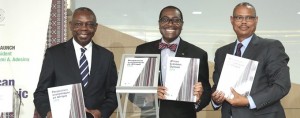African bank bullish on Uganda as debt concerns ease

AfDB President, Akinwumi Adesina (centre) said the pace of industrialisation has be stepped up across the continent.
January 18—The African Development Bank (AfDB) is positive on Uganda’s economic prospects during 2018, a view backed by receding worries about the country’s foreign debt level surpassing the critical 50% of GDP threshold in the near future. Debt-to-GDP is currently just under 40%.
According to African Economic Outlook 2018 report launched in mid-week by the AfDB President Akinwumi Adesina , Uganda’s economic performance generally remained strong despite the recent slowdown in real GDP growth, which is projected to reach 5.9% in 2018, up from 4.8% in 2017 and 2.3% in 2016.
Adesina said the pace of industrialisation and diversification of economies across the continent must be stepped up. He toldAfrican governments to encourage a shift toward labour-intensive industries, especially in rural areas where 70% of the continent’s population resides. “Agriculture must be at the forefront of Africa’s industrialisation,” he said,
He said an integrated power and adequate transport infrastructure would facilitate economic integration, support agricultural value chain development and economies of scale which drive industrialisation.
The AfDB believes the increase in Uganda’s economic growth in 2018 is expected to be driven mainly by public infrastructure investment; recovery in manufacturing and construction; and improvements in the services sector, particularly financial and banking, trade, transport, and information and communication technology services.
Uganda pursued a cautious expansionary fiscal policy stance to support key infrastructure projects in transport and energy, while keeping recurrent expenditure under control. The overall budget deficit was slightly high in 2016, improved in 2017, and is projected to increase in 2018 and 2019.
However, the balance of payments deteriorated, mainly as the result of external economic headwinds, including low commodity prices due to slow growth in Europe and China and tightening global financial and monetary conditions. The macroeconomic policy stance remains focused on containing inflationary pressures, enhancing exchange rate stability, and stepping up domestic resource mobilization growth by 0.5 percentage point of GDP. Uganda continues to have a low risk of debt distress. However, the debt-to-GDP ratio is increasing and is projected to reach 38.6% of GDP in 2016 and 45% by 2020 from 34.1% in 2014.
At these growth rates, the debt burden is growing faster than government resources; the revenue-to-GDP ratio stands at only 13.4%. However, the most recent International Monetary Fund and World Bank Group debt sustainability analysis in 2016 gives Uganda’s risk of debt distress a low rating.
The main tailwinds for the 2018 economic outlook include increased agricultural production due to better weather conditions; higher foreign direct investment (FDI) flows following the recent issuance of oil exploration licenses; and the expected decision by the government to invest in oil infrastructure development in early 2018, given the projected increase in oil prices to an average of $55 a barrel in 2017–18 from $43 a barrel in 2016.
On the other hand, major headwinds include external risks to economic performance include low commodity prices and demand for the country’s exports in major markets, appreciation of the US dollar due to expected monetary tightening by the United States, tightening of global financing conditions that could discourage FDI and development assistance, adverse spillover shocks from fragile regional neighbors, and adverse environmental shocks. Major internal risks include reduced domestic revenue mobilization and higher public spending on contingencies, poor institutional capacity and governance, and weak public financial and investment management systems.

 African Heads of state head to South Korea next week for Summit talks
African Heads of state head to South Korea next week for Summit talks
 Trading leads as main source of income for Ugandans
Trading leads as main source of income for Ugandans
 New leadership for bankers’ umbrella as total assets top $12 billion
New leadership for bankers’ umbrella as total assets top $12 billion
 Brussels Airlines to announce Nairobi service
Brussels Airlines to announce Nairobi service
 SITA promises enhanced travel experience after Materna acquisition
SITA promises enhanced travel experience after Materna acquisition
 Saudia’s 105 aircraft order stretches A320neo lead over rival Max
Saudia’s 105 aircraft order stretches A320neo lead over rival Max
